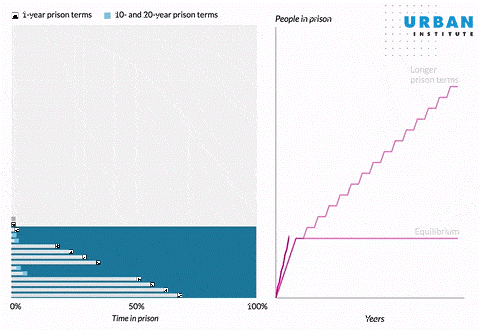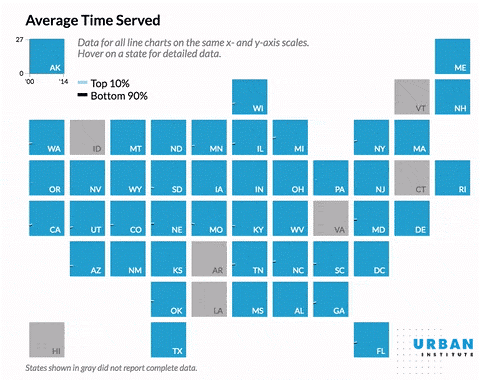To End Mass Incarceration, We Need To End Long Prison Sentences
In 1978, when Monica Jahner was 22, she was sentenced to life imprisonment in a Michigan state prison. Her sentence was for conspiring to murder in the first degree; no one was killed in her case. In prison, the constant stress took a toll on her health: She was regularly rushed to the hospital with a racing heart, and suffered from ulcers and high blood pressure. She lost contact with her family; it was easier, she thought to cut ties than to watch them suffer. But around that, she was working, obtaining a degree and educating herself on the criminal justice system. It took her 10 years to get before the state parole board, and another 18 and the help of a prisoner-advocacy organization after that to finally walk free. Now 52, she’s helping former inmates to reintegrate and advocating for those still inside.
Cases like Jahner’s are not unique. The rate of incarceration in the U.S. has more than quadrupled since the 1970s, when Jahner was convicted; around 2.2 million people in the country are currently behind bars. The reasons are myriad, and include the criminalization of non-violent offenses, and lack of attention and resources devoted to developing alternatives to imprisonment. But a new project from the Urban Institute drills down into one reason in particular: unnecessarily long prison sentences.

Imagine, the report asks, if everyone convicted of a crime stayed in prison for a year. As new people enter, others leave, and the prison population would remain stable. But that’s far from the case. Instead, people cycle in and out on shorter sentences, but in the background, people serving longer terms–20 or 30 years, or life–begin to add up. Especially as states began to eliminate their parole boards in the 1980s and 1990s, or otherwise restrict leave policies, the prison population ballooned.
The consequences of long sentencing, says Ryan King, lead researcher on the project for the Urban Institute, are often obscured by the way in which term-length data is collected. The traditional measure of time served, he tells Fast Company, is to average the length of prison terms for all people released in a given year. That method overrepresents people serving shorter terms; those on longer sentences are not counted.
To rectify the data picture, the Urban Institute instead took snapshots of everyone who was still in prison at the end of a given year, and how much time they have served. So someone who was convicted in 1995 with a 25-year sentence would not, under traditional methods, be counted until 2020, but the Urban Institute’s method rolls up their time served (10 years in 2005, 15 in 2010) with the data on average term times. The data is interspersed with personal stories, like Jahner’s.

“This is part of the mass incarceration conversation that has not had the light shown on it,” King says. In recent years, criminal justice reform has focused on reducing sentences for low-level offenses like property crimes or drug possession; a new initiative from the National League of Cities, for instance, is providing cities with technical assistance to develop ways to divert people suffering from mental illness or drug addiction out of the justice system and into treatment and supportive services. “These are all incredibly important steps to be taking,” King says. “We need to continually be asking: Is prison the right sanction here? Are there other things we can do?” A growing body of research has sprung up around the personal and community-level benefits (not to mention, financial–mass incarceration has racked up a national bill of around $182 billion) of keeping people out of jails and prisons.
But there is not enough clarity on how to tackle mass incarceration from the perspective of people already inside the system. “We haven’t developed the foundational research to identify what alternatives work,” King says. “If somebody has committed a violent offense, there are very few options for them out there besides prison.” And that’s a result, King says, “of the fact that we’ve all just turned our heads and said, ok, those people are locked up, let’s ignore them.”
So what’s to be done? The Urban Institute had developed a set of core principles that they believe should guide decision-making in the criminal justice system, including that sentences should be proportionate to the crime, that everyone should be offered a meaningful chance of release, that reforms should address racial and socioeconomic bias, and that avenues for justice must being to extend beyond incarceration.
And from there, the Urban Institute recommends a series of policy changes, that at their core, advocate for a more individualized and holistic approach to sentencing. State-level mandatory minimums should be eradicated, as should requirements that people serve out a set amount of time regardless of personal progress while incarcerated. Opportunities and incentives to pursue that progress and secure early release, King says, also need to be developed and funded. More restorative justice programs, like Restore Oakland–a justice facility that will offer workshops and holistic re-entry services, including job placement–need to be piloted and funded, and become the norm, rather than the exception, while other efforts should be geared toward researching and developing pre-incarceration violence-reduction strategies at the community level.
“We’ve not just ignored the people in prisons; we’ve ignored the issue entirely,” King says. “We’re got to be invested in finding out what works to end and address violence.” To King, it’s been maddening to watch attorney general Jeff Sessions vow to enforce tougher sentencing and criminalization laws, while making no overtures to develop violence prevention strategies and inmate treatment programs. “If your solution is to hire more prosecutors and more law enforcement, and just lock people up and throw away the key, our report shows that this is just not working.”
We should be funneling resources toward developing comprehensive violence-reduction strategies and supporting inmate care and early-release programs. Instead, we have people sit in prison forever.
In 1978, when Monica Jahner was 22, she was sentenced to life imprisonment in a Michigan state prison. Her sentence was for conspiring to murder in the first degree; no one was killed in her case. In prison, the constant stress took a toll on her health: She was regularly rushed to the hospital with a racing heart, and suffered from ulcers and high blood pressure. She lost contact with her family; it was easier, she thought to cut ties than to watch them suffer. But around that, she was working, obtaining a degree and educating herself on the criminal justice system. It took her 10 years to get before the state parole board, and another 18 and the help of a prisoner-advocacy organization after that to finally walk free. Now 52, she’s helping former inmates to reintegrate and advocating for those still inside.
Fast Company , Read Full Story
(20)






